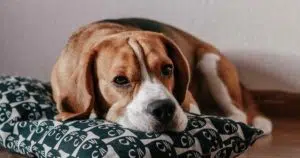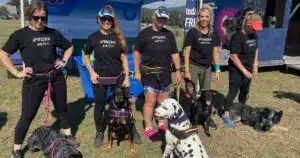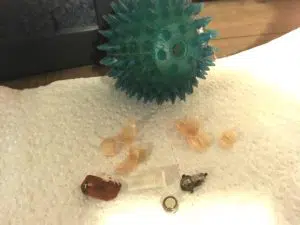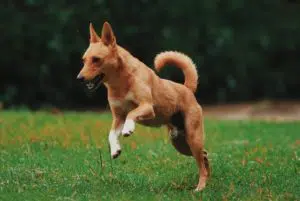
A behaviour that has many dog owners tearing their hair out in frustration is destructive chewing.
Especially, as there are many reasons for why a dog might be chewing through every pair of shoes in the house, or pulling apart your back yard bit by bit.
Chewing is a natural instinctive behaviour. This, like a lot of other behaviours that owners perceive to be a problem behaviour or unacceptable in their dog, begin when it is a puppy and can be directly related to survival instincts, instinctive to the puppy, and because it is then inadvertently reinforced by owners.
Despite what many owners think, it is not being done out of guilt.
Chewing is important for the puppy’s sensory development, it is a way they can explore and learn about their environment and the world around them. They also do it when they are teething, so for specific help with teething puppies, click here.
Anyone that has had a puppy will attest to how much time it can spend running around the house or yard picking up and chewing on things. How are they to know they shouldn’t pick up that interesting shiny object that catches their eye, the soft squishy toy that makes such interesting sounds or soothes their gums whilst they are teething?
Once this is understood and we think about it from the dog’s perspective, we can start to address the destructive chewing in an appropriate way and, most importantly, whilst the dog is still young.
Our main aim is to prevent the inappropriate chewing from becoming an established habit, and we definitely don’t want to encourage it by chasing them around trying to grab the item out of their mouth.
Think about how much fun a puppy or a growing adolescent will have getting your undivided attention when it picks up your shoe or item of clothing, or perhaps they may even get to play a game of chasey around the house too! What a great reward that would be, and remember, when we reward a dog for doing something we are reinforcing it, making it occur with more intensity and frequency. Good or bad. The best thing to do is to teach your dog ‘leave it’ so for tips on that, click here.
The cause or reason for destructive chewing in an older dog can be varied and many.
It may be because appropriate measures weren’t taken as a puppy to prevent it, so it has become a long-standing behaviour that may still get inadvertently reinforced. Particularly if there is a continued lack of leadership, consistency or setting appropriate boundaries to prevent the dog from getting it’s own way.
Opportunity
However, assuming you did all the right things when it was a puppy to curtail destructive chewing, yet it still happens from time to time or even suddenly intensifies, reasons could include self-rewarding behaviour (ie: a fun game of ripping or tossing it’s bed or blankets), or pure opportunity (did you leave those sweaty sneakers smelling of you, their most favourite person ever, laying around just begging to be chewed?).
Boredom
If your dog is left alone all day, or destructive chewing seems to only occur when you go out, it could be boredom or Separation Related Behaviour (commonly known as separation anxiety). A useful way to determine which of the two it may be is to video the dog in your absence.
As a general rule, if a dog starts displaying Separation Related Behaviour (SRB) such as destructive chewing soon after you leave home, it is also likely you would also see other SBRs such as vocalisation, digging, pacing, excessive greetings, inappropriate elimination or loss of appetite.
Whereas destructive chewing and other behaviours like digging tends to start later in the day, indicating it is more likely due to boredom/frustration.
Inadequate diet
Diet can also play a role in destructive chewing. If a dog is not being fed an appropriate diet to meet all of its nutritional needs this could result in destructive chewing habits, as the dog starts seeking out plants or bark, eating rocks, dirt and sometimes even cement, containing a certain mineral or vitamin that they are missing. (Yes even a wall could contain a nutritional element they are short on!)
Whilst a proper assessment of the situation and/or help by a certified and experienced trainer is recommended for treating serious destructive chewing behaviour, there are a few treatment options to try at home yourself as a start.
Implementing as many of them as soon as possible should see a reduction in destructive chewing as you divert this energy in a more productive way.
Restrict access
If you are dealing with a teething or young pup exploring the world around it, then start with reading our How to Puppy Proof Your Home article to help prevent it becoming a long-term problem.
If your dog tends to chew at certain plants, pipes or other household items that you can’t move, then restrict their access to that area so it isn’t continuously reinforced.
Make sure the yard is free of prospective times ie: shoes, toys, rubbish, garden hoses, plants etc. to remove the temptation.
Spray some bitter or bad tasting (but non toxic) material on plants or items that your dog likes to chew. Try the Rufus & Coco Chew Stopper for a safe and bitter option.
Provide safe alternatives
Provide alternatives for your puppy or dog to chew or play with when you are around to deter destructive chewing – safe, non toxic and appropriately sized options such as the Aussie Dog Puppy Pack , Mitch Ball or their awesome new Buddy Ball when you can initiate the activity on your terms, not theirs!
If you catch your dog in the act, then divert or distract this unwanted behaviour and replace it with a desired action that you can then reward with a treat or a game – obedience training can help here.
Improve their diet by decreasing or eliminating all processed foods and adding fresh or raw food, vitamins and minerals and appropriately sized bones. Bones provide other benefits for addressing destructive chewing as well.
Environmental Enrichment
If it is boredom or anxiety related then a wider treatment plan is recommended, especially if other problem behaviours are also occurring alongside destructive chewing.
Environmental enrichment plays a big part in this and aims to provide the dog with the stimulation and exercise they need in order to keep them healthy and happy, and to help prevent problem behaviours such as destructive chewing.
Interactive Toys designed to keep the dog mentally and physically stimulated when you can’t be around can help. The Aussie Dog products such as the Bungee Chook, Home Alone , Tucker Ball and the Buddy ball, and other interactive toys to suit a wide variety of breeds.
Rogz interactive toys that can help too. You can find these all at your local Petstock store or website.
These treatments combined should help stop or weaken destructive chewing behaviour.
Get professional help
However, if it is stemming from a more problematic issue such as SBR (separation anxiety) then further treatment options may be required. Check out our article on SBR/anxiety for further information and speak to your Vet or dog behaviourist.
The other thing to remember is that often owners reprimand their dog after the fact, rather than when it is caught in the act, so it has no direct association that it was the destructive chewing that led to the reprimand. This is not only ineffective in addressing the problem; it may also cause further behaviour problems in your dog so use positive reinforcement training with your puppy or dog. Read why this is the case in our ‘guilt’ article.
If you are dealing with a severe destructive chewing issue then don’t wait for the dog to grow out of it…it won’t! Enlist the support of a certified and experienced trainer to help.
About the Author: Lara Shannon is a certified dog behaviourist and trainer, pet food nutrition specialist, Executive Producer and Host of Pooches at Play on Channel 10 and editor of Poochesatplay.com. Lara also runs her own dog training business in Melbourne’s Bayside area and is the Author of World of Dogs and Eat, Play, Love Your Dog


Choosing a dog collar and lead

Toilet Training a Puppy for success

The dangers of cheap and chewable dog toys

Tips for training a reactive dog


Get your paws on Lara Shannon’s best selling books ‘Eat, Play, Love (your dog) and World of Dogs.
Available in Australia, USA, UK and Canada.